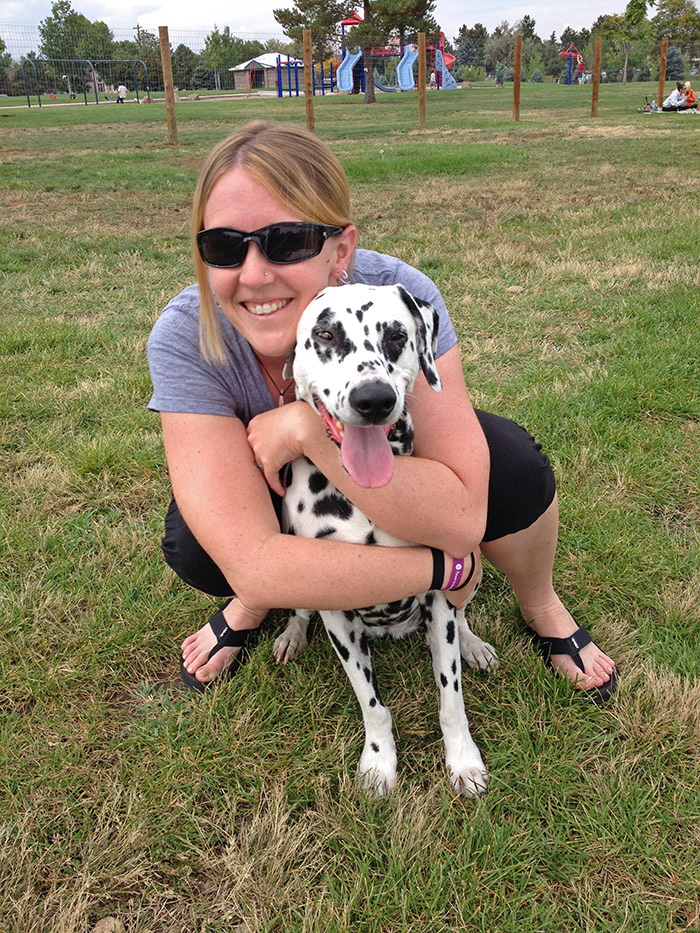What It’s Like to Raise a Deaf Dog
This is definitely one of those things that can certainly be “to each their own”, just like raising any other dog, pet or tiny human. But for me, it wasn’t hugely different from raising a hearing dog. While my first dog was 2 when I got her, I helped raise puppies as a kid and have since had 2 puppies after Faith. The biggest differences with Faith were usually due to her personality, her breed and my knowledge (or lack thereof).
Dogs don’t speak our language, so to train any dog, we have to learn a bit of their language. And dogs rely on lots of body language. That’s why most dog trainers recommend using visual cues, as you speak. I believe dogs can learn a bit of English, but if you don’t speak, but use your visual cues, they will often still do the task – even without the verbal cue. And this is like training a deaf dog. Lots of deaf dog owners utilize ASL (American Sign Language) and/or make up their own hand gestures. As long as you’re consistent, it doesn’t really matter what signals you use.
So for me, teaching Faith, was not much different from teaching hearing dogs. Here were the only big differences I experienced:
- I couldn’t call Faith to me, if she couldn’t see me. Creativity was key here, in making sure she could see me. At the dog park, I’d wait until she looked in my direction and then flap my arms like someone trying to land a plane. And inside, depending on the floors, I could potentially stomp to get her attention if she wasn’t looking. Luckily, deaf dogs have a reputation for being “velcro” dogs (as do Dalmatians – so Faith was doubley velcroy). This means they like to follow you everywhere – even the bathroom!
- Off-leash is definitely not the wisest. If they see something and run, there is NO calling them back. Once I knew Faith well and she was fully grown and trained, there were very few times where I felt ok to have her off-leash. There some tricks I’d use on rare occasion when camping, like bear bells, or dog packs I knew she’d stick with, but in general it is highly risky and not recommended. I very rarely had her off leash, but we sure used fenced in dog parks a ton.
- Deaf dogs can startle easily. Luckily this wasn’t much of an issue for Faith – possibly because I helped condition her from a young age. She mostly didn’t get startled and when she did it was more of a “whoah” with a jump back (she never lashed forward or snapped).
- Deaf dogs sleep through LOTS of stuff. This is certainly a bonus – if Faith was sleeping, she could be passed out for a long time, because those small noises that disturb hearing dogs, didn’t wake her. And boy, did she LOVE sleeping in – she was like a teenager! On rare occasion, we had to be mindful, like when the maintenance guy came in one day and she was sleeping. After he’d been there about 20 minutes, Faith suddenly started moving her nose around and then woke up gently growling and gruffing looking around, wondering what was going on. (You could tell she suddenly got a whiff and didn’t recognize the smell and panicked a bit.) Once she saw me and realized all was ok, she was totally fine and went over to the guy for some pets. But you bet the maintenance guy was a bit perplexed until I explained she was deaf, which is why she’d been asleep that whole time!
So really, for me, it wasn’t hugely different. With some research, a little bit of extra patience and understanding, Faith was mostly like any other dog.
The above information is my personal findings and experience. If you have a deaf dog or are considering getting a deaf dog, Deaf Dogs Rock is a great organization that helps find homes for deaf dogs, and they have a wealth of information available.

Tracy with Faith at a Deaf Dogs Play Day
